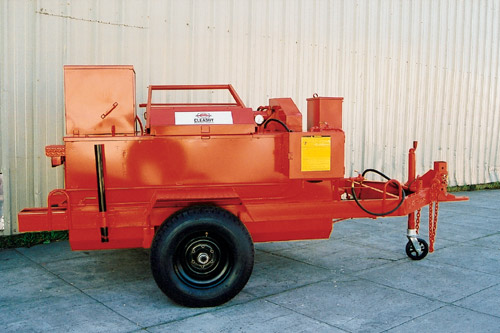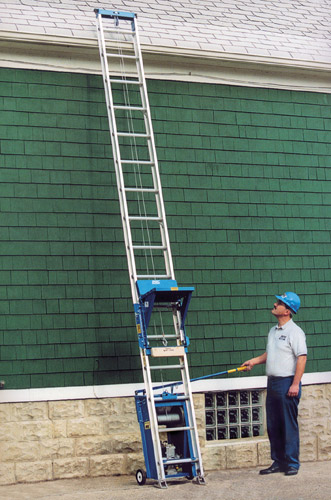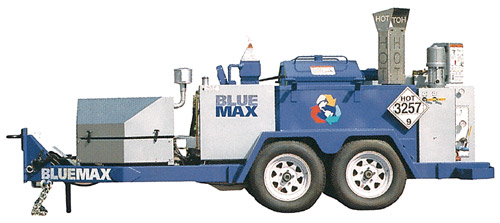In 2001, Professional Roofing reported on technological advances in the roofing industry and highlighted some products showcased at NRCA's 114th Annual Convention and Exhibit.
But regardless of how things may change and improve technologically, roofing contractors cannot effectively perform their jobs without using heavy equipment.
This year, Professional Roofing met with several equipment manufacturers during NRCA's 115th Annual Convention and Exhibit in San Antonio. Following are descriptions of some of their offerings. The descriptions should not be construed as endorsements or recommendations of Professional Roofing or NRCA.
Cleasby Manufacturing
Cleasby Manufacturing Co. Inc., San Francisco, introduced its BF 200 Hot-air Rubber Asphalt Melting Kettle at NRCA's convention (see Photo 1). The product's main feature is its hydraulically driven, full-sweep agitator.

Photo courtesy of Cleasby Manufacturing Co. Inc., San Francisco
Photo 1: Cleasby Manufacturing's asphalt melting kettle features a full-sweep agitator.
Cleasby Manufacturing representatives say a full-sweep agitator is a must given the sensitive nature of the material. Such an agitator is said to help minimize the chances of material burning, eliminate hot spots and maintain a consistent material temperature.
The kettle also automatically regulates a material's temperature, and its controls will shut off once the kettle's pilot light is extinguished.
The kettle's burner generates 550,000 BTUs of energy to melt asphalt materials quickly. In addition, the unit does not require steel heat tubes or electronic sensors, which helps decrease down time caused by equipment failure.
Garlock
The 115 ServicePro Repair Kettle (see Photos 2 and 3) from Garlock Equipment Co., Plymouth, Minn., is a multipurpose repair kettle contractors can use to store mops and mop carts, felt rolls, asphalt containers, hand tools, generators, brooms and other tools.


Photos courtesy of Garlock Equipment Co., Plymouth, Minn.
Photos 2 and 3: Garlock's repair kettle helps contractors keep job sites clean.
The unit, which can be hitched to a pickup truck, features a built-in 115-gallon (437-L) kettle, lockable utility cabinet and mount for a 100-pound (45-kg) liquid-petroleum cylinder.
Garlock representatives believe the unit will help contractors project more professional images at job sites while allowing convenience for roofing workers.
Garlock also introduced its SuperMax 2000 Hydraulic Hoist. The hoist offers 2,000-pound (900-kg) single-line hoisting power, as well as 160-feet-per-minute (48-m-per-minute) line speed. According to Garlock representatives, hydraulic power is required to release the equipment's brake and lift a load. An optional counterbalance, which can be filled with 1,000 pounds (450 kg) of concrete, also is available. (Garlock provides 12 weight cans mounted into a tray; each weight can is filled with concrete and weighs 80 pounds [36 kg].)
Reimann & Georger
Also at the convention, Reimann & Georger Corp., Buffalo, N.Y., released its PRO Platform Hoist (see Photo 4). Unlike other hoists, the product has wheels. In addition, it features cast-aluminum shoes on 16-foot- (4.8-m-) long base tracks, as well as a single-hand control that is located on the unit's side.

Photo courtesy of Reimann & Georger Corp., Buffalo, N.Y.
Photo 4: Reimann & Georger's PRO Platform Hoist features a single-hand control for increased safety.
Reimann & Georger representatives say the hoist was engineered with workers' safety and productivity in mind.
The hoist is available in two models—the PRO400 and PRO200. The PRO400 model has a 400-pound (180-kg) lifting capacity; 110-feet-per-minute (33-m-per-minute) lifting speed; 24- by 24-inch (610- by 610-mm) platform size; and 24-inch- (610-mm-) wide track. The PRO200 model has a 200-pound (90-kg) lifting capacity; 220-feet-per-minute (66-m-per-minute) lifting speed; 12- by 17-inch (305- by 432-mm) platform size; and 17-inch- (432-mm-) wide track. Both models are 44 feet (13 m) high and feature gas engines or electric motors.
The hoist's brake rope design allows for feathering of the brake, which reportedly provides a safer, smoother and more controlled platform descent than a brake belt design.
An aspect that makes the hoist versatile is the number of accessories that are compatible with it. For example, the PRO400 Plywood and Truss Carriers attachment is available. The accessory lifts plywood, skylights, roof trusses, framing material and other objects. And the PRO400 Gravel Hopper lifts granular materials and discharges loads into wheel barrows, spreaders and other containers.
Reeves Roofing Equipment
Another product designed to make work easier is Helotes, Texas-based Reeves Roofing Equipment Co. Inc.'s Pallet Jack. The product can lift up to 2,500 pounds (1125 kg) of 4- by 4-foot (1.2- by 1.2-m) pallets and 500 pounds (225 kg) of 4- by 8-foot (1.2- by 2.4-m) pallets. The jack lifts pallets 10 feet (3 m) high. When roofing workers use the product, they do not have to remove the pallets' protective wrapping. Materials, therefore, can be distributed on a roof and still be protected from weather.
Urecoats
Urecoats Industries Inc., Deerfield Beach, Fla., has made available its BlueMAX™ Model 230 spray application system (see Photo 5) that is compatible with its UrecoatsRSM-100™ sealant, a product made from recycled crumb rubber, polyurethane, asphalt and other additives. The sealant is fully adhered and compatible with steel, concrete and roof decks.

Photo courtesy of Urecoats Industries Inc., Deerfield Beach, Fla.
Photo 5: Urecoats Industries has released its BlueMAX™ Model 230 spray application system.
"We believe our product offers roofing contractors a better roofing solution that they can efficiently deliver to their customers while substantially reducing their cost of labor," says Timothy Kardok, chief executive officer and president of Urecoats Industries.
BlueMAX is designed to mix, meter and spray apply the sealant and can yield up to 10,000 square feet (900 m²) of sealant per day with a four-person crew. Curing reportedly begins when the sealant is sprayed onto a substrate. The machine can pump up to 350 feet (105 m).
Before roofing professionals can use BlueMAX, they must attend a training program at Urecoats Industries' training facility. The two-day program consists of classroom and hands-on training that addresses safety; material loading, handling and storage; machine transporting and set up; operational roles; maintenance; and other topics. After the program, certified contractors receive on-site help from a Urecoats Industries' technician.
A snapshot
The products mentioned in this article only are a few of the many equipment options available to roofing contractors. For company contact information or to research other companies, access the NRCA Buyers Guide at www.nrca.net.
Kate Gawlik is Professional Roofing's associate editor, and Ambika Puniani is Professional Roofing's editor and NRCA's director of communications.
